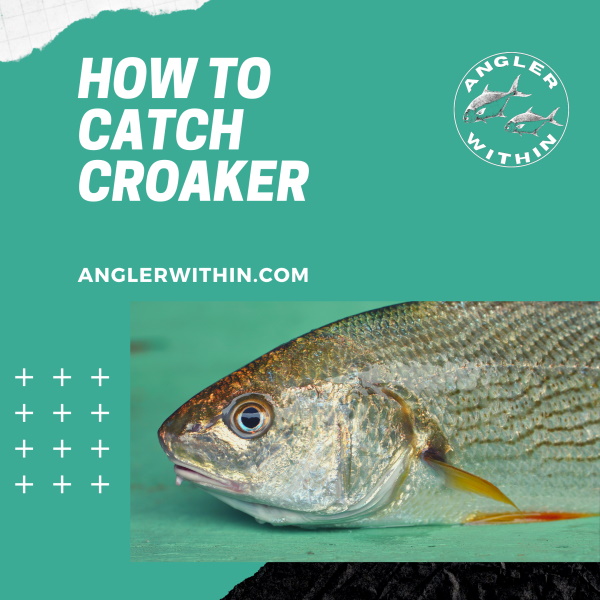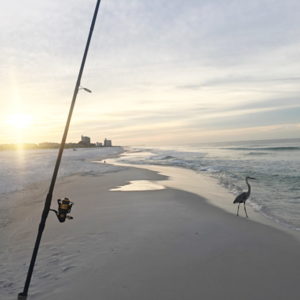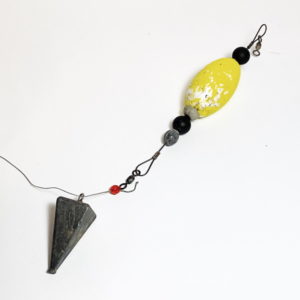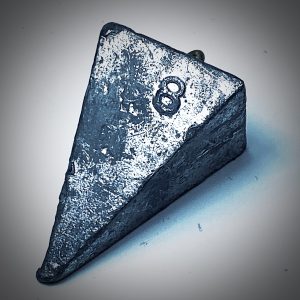
To catch Atlantic Croaker, you’ll want to target them after winter passes, and the water temps have warmed up. The best times will vary slightly by region, but generally this will be from late spring through fall. You’ll find them in highest concentrations when the water temps surpass 75 degrees.
Sandy or muddy bottoms are the most preferred habitat. They will commonly be found in the surf, and around bridge and pier pilings.
Bait up with a small live shrimp, or a piece of cut bait, and send it to the bottom. With their downturned mouths, croaker will be found feeding along the bottom, so that’s where you should target them.
For further details on how to locate and target this underrated species, keep reading below.
A Little About The Atlantic Croaker
Species
Micropogonias undulatus
The Atlantic Croaker is related to the drum family, and as you might expect, the males make a croaking sound similar to the other members of that family. I remember the first one I ever caught. There was no mistaking what it was, as the loud croaking sound gave it away immediately.
Croakers are the loudest “drumming” fish of the drum family.
Size
Although croakers commonly weigh in under a pound, mature fish can regularly reach weights of 4 pounds or more. So, they aren’t exactly a small fish, per se.
Believe it or not, the world record croaker is 8 lb. 11 oz. and was caught in 2007 in Virginia waters. It crushed the previous record.
Shape
Croakers are shaped a bit like a black drum, and have a mouth much like a red drum. They also have the whiskers, or barbels, on their chins like black drum do. Although they are of a similar shape, you wouldn’t tend to mistake them for black drum since the coloration is very different.
Spawn
Normally croakers are a pinkish silver color, but during the annual spawn they can change to a bronze yellowish golden color. Because of this spawning coloration, they are sometimes referred to as “golden croaker” (in Texas). The spawn generally occurs around September, or later, depending on region.
Where To Find Croaker
Range
Atlantic Croaker range from Texas to Massachusetts and can be encountered in the surf, as well as inshore. Along the Gulf, they are most prevalent in Louisiana and Mississippi.
Although croaker can be found from New England to Texas, they are rarely encountered south of Indian River Lagoon in east Florida, or south of Tampa Bay on the west side of Florida.
Habitat
When the water temps are favorable, from spring through fall, they can be found inside estuaries, bays, and the inlets leading into them.
Croakers tend to frequent areas with sandy or muddy bottoms, but they will also be found around natural hard bottoms, such as oyster reefs. You’ll find them hanging around bridge and pier pilings, and in the surf just off the beaches. However, when the temps plummet they move offshore for winter.
Croakers Feed On Bottom
As previously mentioned, croakers have downfacing mouths. Therefore, they are predominantly bottom feeders.
Best Times To Catch Croakers
Temperature is the driving force that controls the appearance of Atlantic Croaker. They will start showing up around inland waters when the temps get close to 60 degrees, and are most abundant when the water temps are over 75 degrees.
In the Gulf, you can catch them from spring through fall, until they migrate offshore when the water gets too cold. Further north, you’ll find them summer through fall.
They are schooling fish. So, when you locate them you can sometimes catch a lot of them.
It’s time to fish for croakers when the water temps hit about 60 degrees.
Best Baits For Croaker
Although they will hit artificials, it’s best to stick with natural baits when targeting croaker. Something from the list below should server you well.
- Live Shrimp
- Sand Fleas
- Dead Shrimp
- Small Crabs
- Bloodworms
- Squid
- Clamp
- Ghost Shrimp
- Cut Bait
- Fishbites
Shrimp are often considered the best baits to use for croaker. Live shrimp, dead shrimp, sand fleas, small crabs, cut bait and squid are all effective. Just make sure to use fairly small pieces.
You can fish your shrimp or other bait on a jig head, a fish finder rig, or even a sabiki rig. Just make sure whatever bait you’re using is on the bottom.
Catching And Landing Them
From The Beach
The biggest challenge to catching croaker in the surf, is to hook one before a whiting or species gets your bait. At least that’s the issue where I fish for them. The same baits used for croaker also entice whiting (aka kingfish) and many other fish as well. With that said, whiting are another good eating fish that’s also fun to catch. So, if you’re interested in more info on how to catch those, check out my article about that here How To Catch Whiting.
Rod and Reel
Croaker are generally pretty easy to catch. You don’t need any sort of special gear to target them. Pretty much any rod and reel setup should do just fine.
Best Rigs For Croaker
Use a jig head, a double hook rig, or simply a 1/0 – 2/0 circle hook with a split shot. It’s important to use enough weight to get your bait to the bottom, because that’s where they’re going to be.
Handle Them Carefully
After you catch a croaker, be careful handling them. Like many saltwater fish, they have sharp pokey places on their body that can get you if you let your guard down. If you’re fishing with a kid, it’s best if you handle a caught fish for them.
Are Croakers Good To Eat
They are indeed really good to eat. Pan fried croaker are excellent! Simply dip them in cornmeal and fry them up in peanut oil.
Small croakers are a very popular bait for huge speckled trout.
Croaker Regulations
Although croaker can be used as bait for larger species, such as speckled trout, you still need to be sure you abide by any size restrictions in your state. I don’t believe many states have a size limit, except for maybe Maryland and Delaware. However, you need to be sure to refer to the regulations in your state to confirm for yourself before keeping small croakers.
Conclusion
Croaker are both abundant and easy to catch, making them a great species to target for folks of all ages and skill levels. They are also an underrated and a great eating fish. If you end up catching one by accident, add it to your bag and give it a try.
If you found this article helpful, you might also like this one – Surf Fishing Supply List For Beginners



